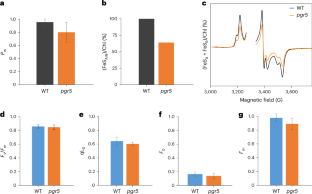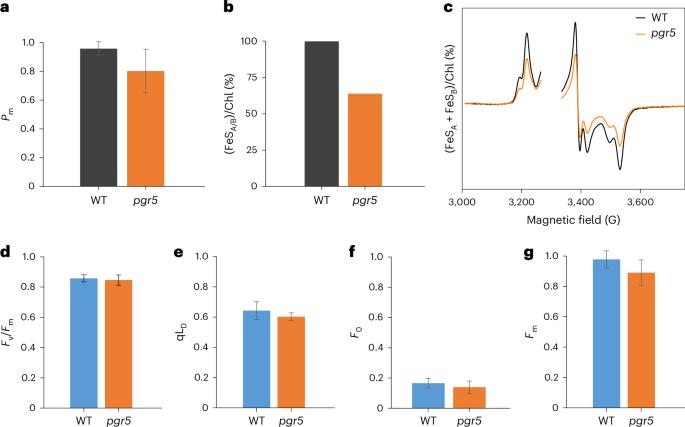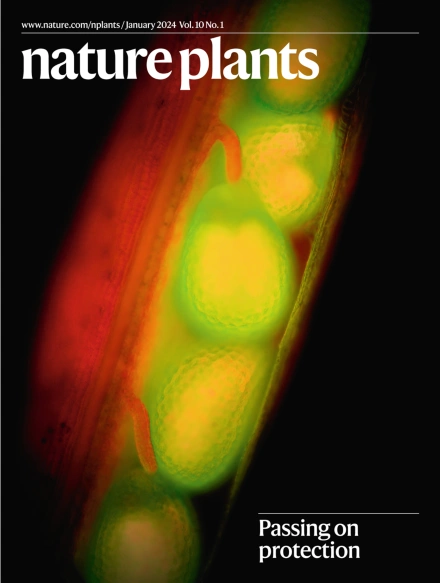不同的 FeS 簇光损伤在调节通过光系统 I 的过量电子流方面发挥着关键作用
IF 15.8
1区 生物学
Q1 PLANT SCIENCES
引用次数: 0
摘要
来自光合系统 I(PSI)的光合电子流主要用于 NADP+ 和 CO2 固定,但总有一部分电子流在替代电子传递和循环电子传递之间共享。虽然从 P700 到铁氧还蛋白的电子传递是通过植物醌和 FeSX、FeSB 和 FeSA 簇进行的,但这些氧化还原中间体在环境胁迫下从 PSI 向 NADP+、替代电子传递和循环电子传递传递电子的过程中的调控作用仍然难以捉摸。在这里,我们提供了拟南芥在强光下 PSI FeS 簇连续受损以及随后在弱光下缓慢恢复的证据。随着强光持续时间的增加,野生型植株的 FeSA/B 簇显示出 10%-35% 的光损伤,但对 P700 氧化能力、FeSX 功能或 CO2 固定率没有太大影响,也没有额外的氧气消耗(O2 光还原)。pgr5 突变体中平行的 FeSA/B 簇损坏在 50-85% 时更为明显,这可能是由于光合作用控制能力较弱和非光化学淬灭较低所致。在 pgr5 突变体中,PSI 上如此严重的电子压力也对 FeSX 簇造成了损害,同时 P700 氧化能力下降,与类木质结合的铁氧还蛋白减少。野生型植物和 pgr5 植物的研究结果表明,在强光下 PSI FeS 团簇的损坏是可控的。在野生型植物中,这有利于电子通过完整的 PSI 中心向线性传输,而不是通过其他途径,从而防止活性氧的产生,并可能促进 P700+ 和 FeSX- 之间的无害电荷重组,只要大多数 FeSA/B 簇保持功能。本文章由计算机程序翻译,如有差异,请以英文原文为准。


Differential FeS cluster photodamage plays a critical role in regulating excess electron flow through photosystem I
The photosynthetic electron flux from photosystem I (PSI) is mainly directed to NADP+ and CO2 fixation, but a fraction is always shared between alternative and cyclic electron transport. Although the electron transfer from P700 to ferredoxin, via phylloquinone and the FeSX, FeSB and FeSA clusters, is well characterized, the regulatory role of these redox intermediates in the delivery of electrons from PSI to NADP+, alternative and cyclic electron transport under environmental stress remains elusive. Here we provide evidence for sequential damage to PSI FeS clusters under high light and subsequent slow recovery under low light in Arabidopsis thaliana. Wild-type plants showed 10–35% photodamage to their FeSA/B clusters with increasing high-light duration, without much effect on P700 oxidation capacity, FeSX function or CO2 fixation rate, and without additional oxygen consumption (O2 photoreduction). Parallel FeSA/B cluster damage in the pgr5 mutant was more pronounced at 50–85%, probably due to weak photosynthetic control and low non-photochemical quenching. Such severe electron pressure on PSI was also shown to damage the FeSX clusters, with a concomitant decrease in P700 oxidation capacity and a decrease in thylakoid-bound ferredoxin in the pgr5 mutant. The results from wild-type and pgr5 plants reveal controlled damage of PSI FeS clusters under high light. In wild-type plants, this favours electron transport to linear over alternative pathways by intact PSI centres, thereby preventing reactive oxygen species production and probably promoting harmless charge recombination between P700+ and FeSX− as long as the majority of FeSA/B clusters remain functional. Photoinhibition of photosystem I and differential damage of FeS clusters under high light levels are natural phenomena in angiosperms that control electron flow to molecular oxygen while maintaining optimal carbon dioxide assimilation.
求助全文
通过发布文献求助,成功后即可免费获取论文全文。
去求助
来源期刊

Nature Plants
PLANT SCIENCES-
CiteScore
25.30
自引率
2.20%
发文量
196
期刊介绍:
Nature Plants is an online-only, monthly journal publishing the best research on plants — from their evolution, development, metabolism and environmental interactions to their societal significance.
 求助内容:
求助内容: 应助结果提醒方式:
应助结果提醒方式:


